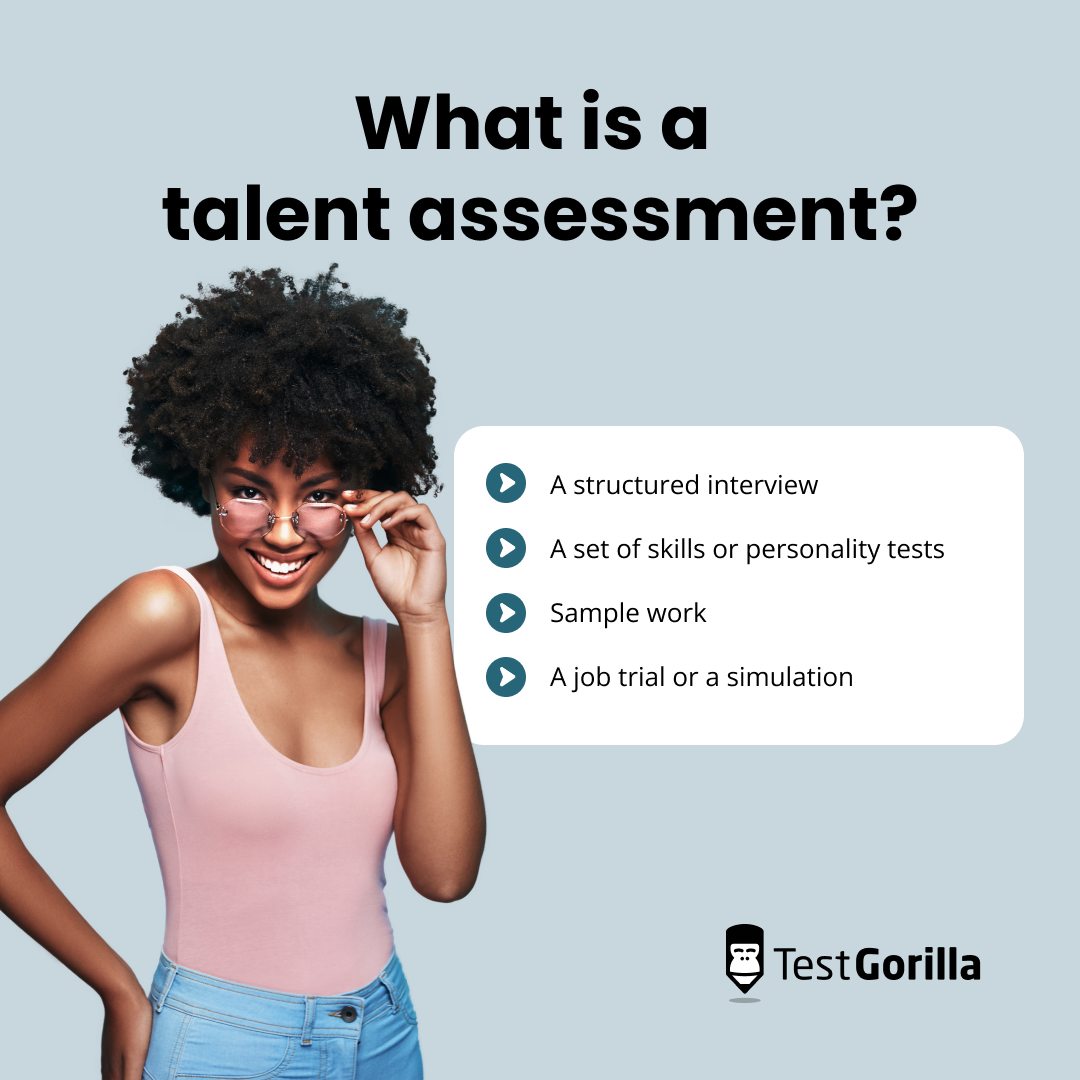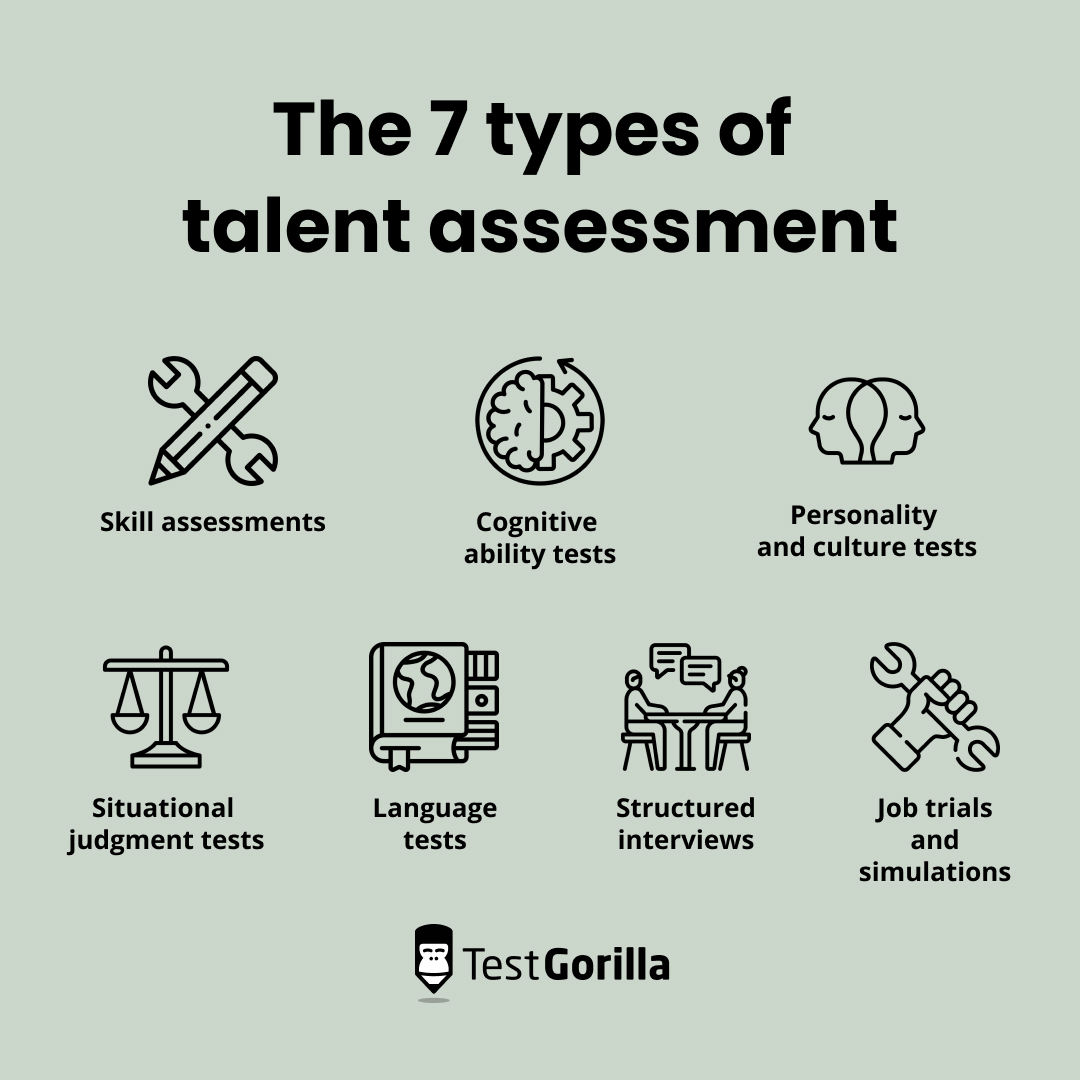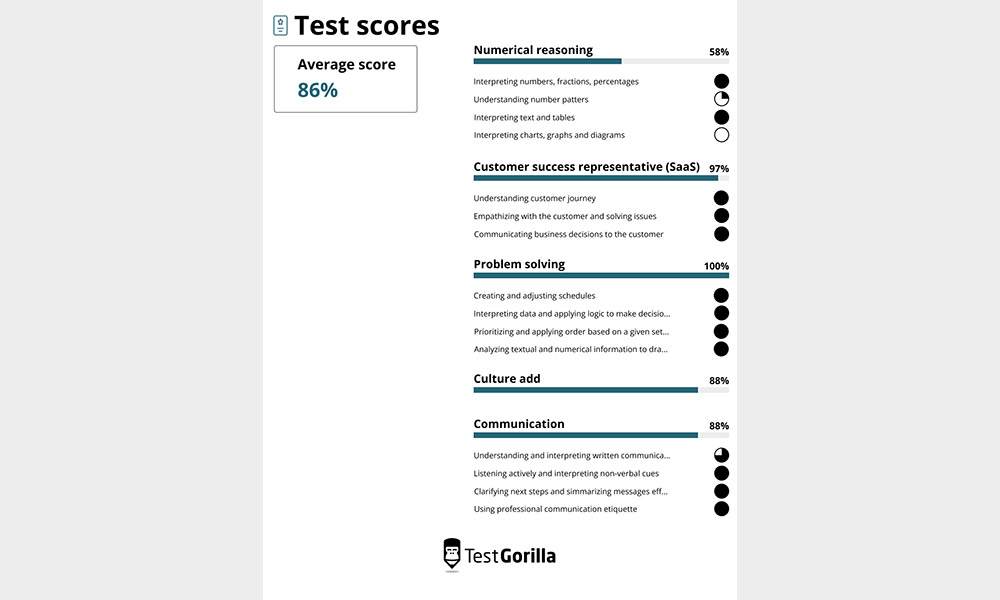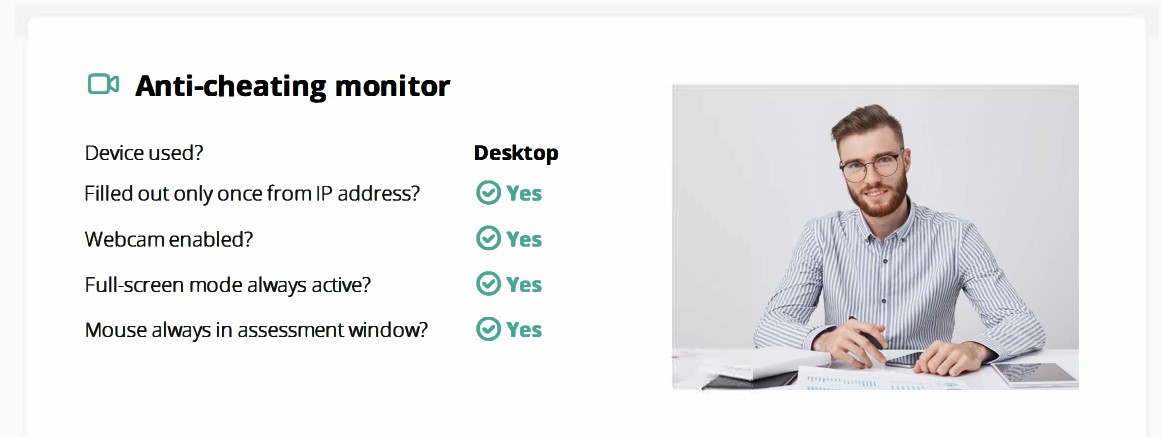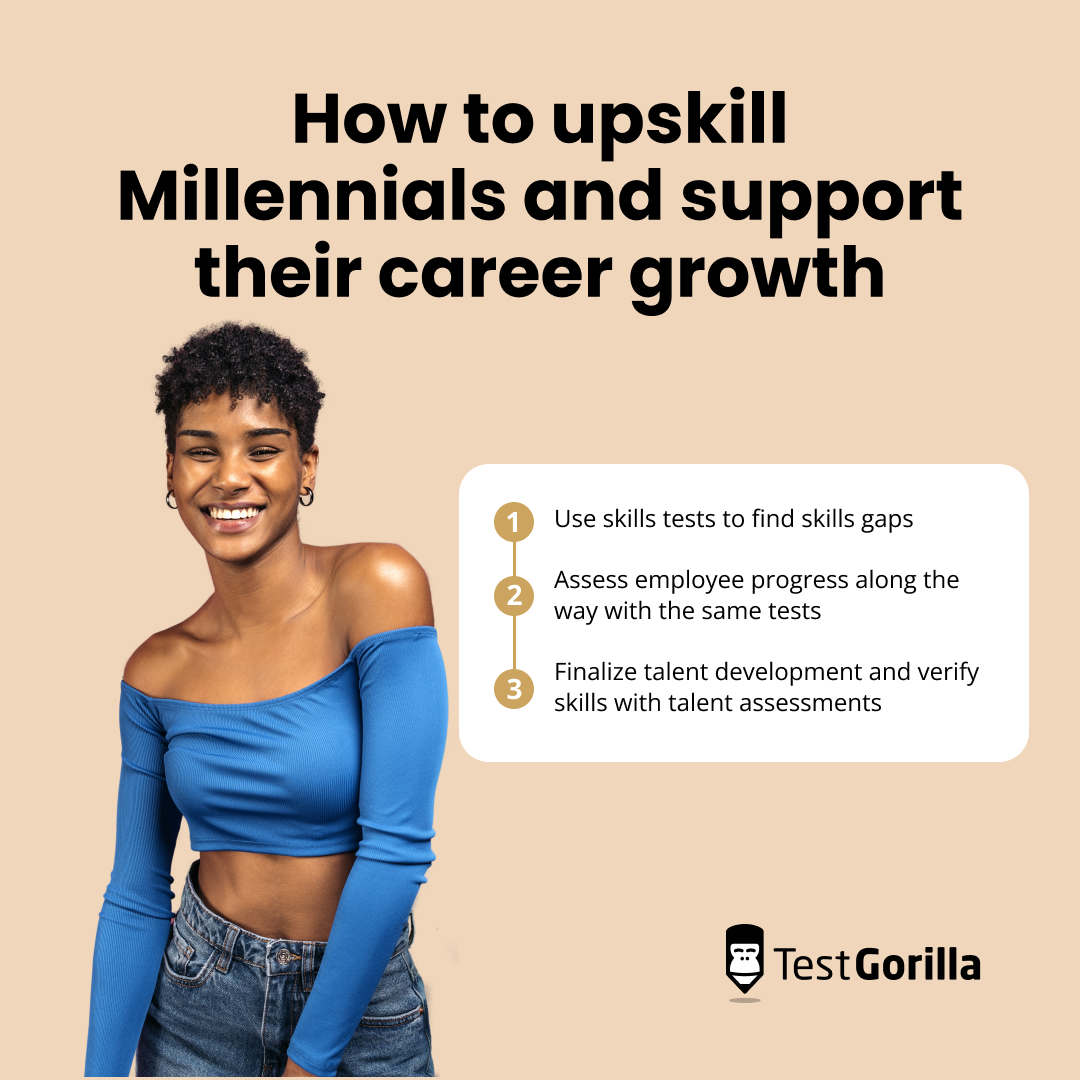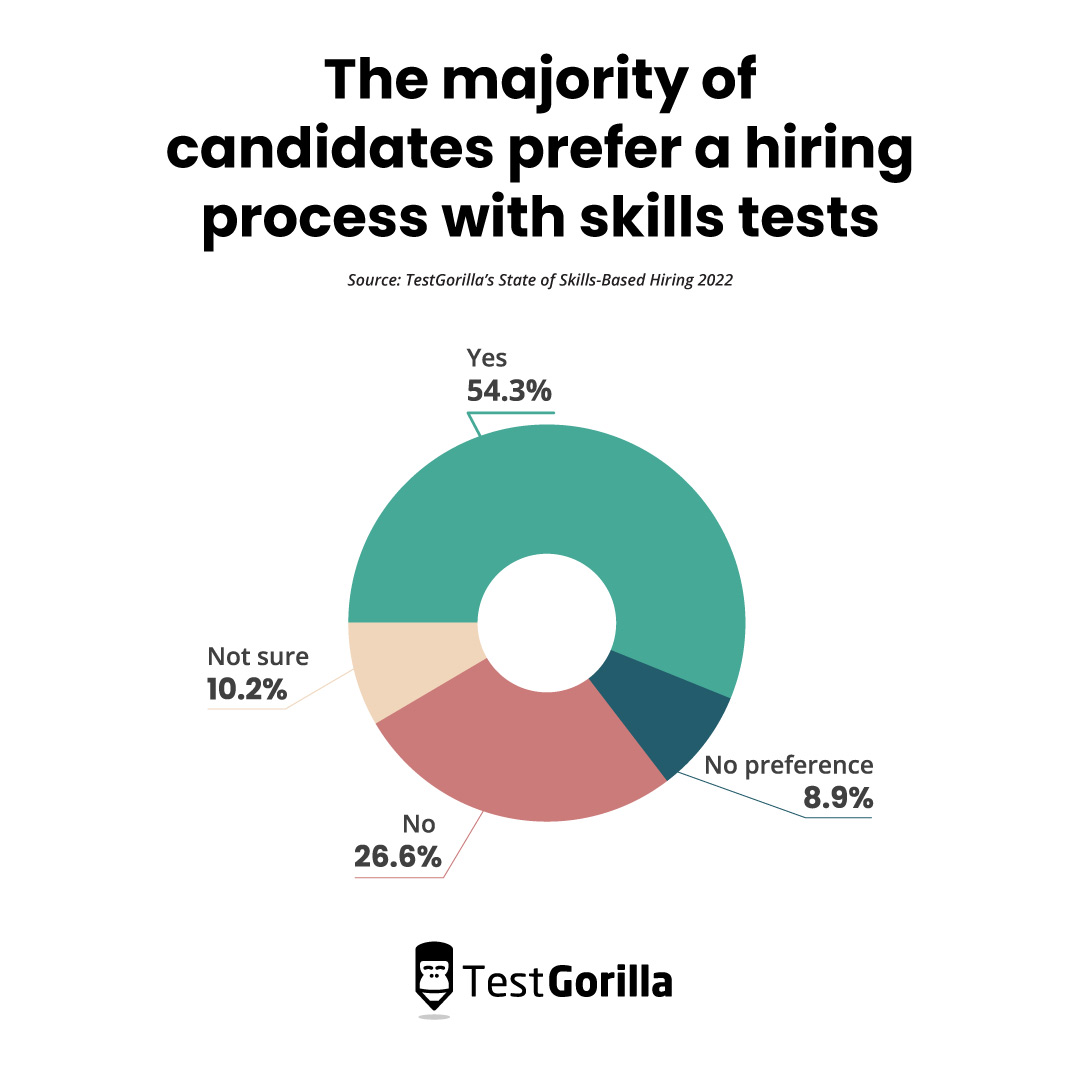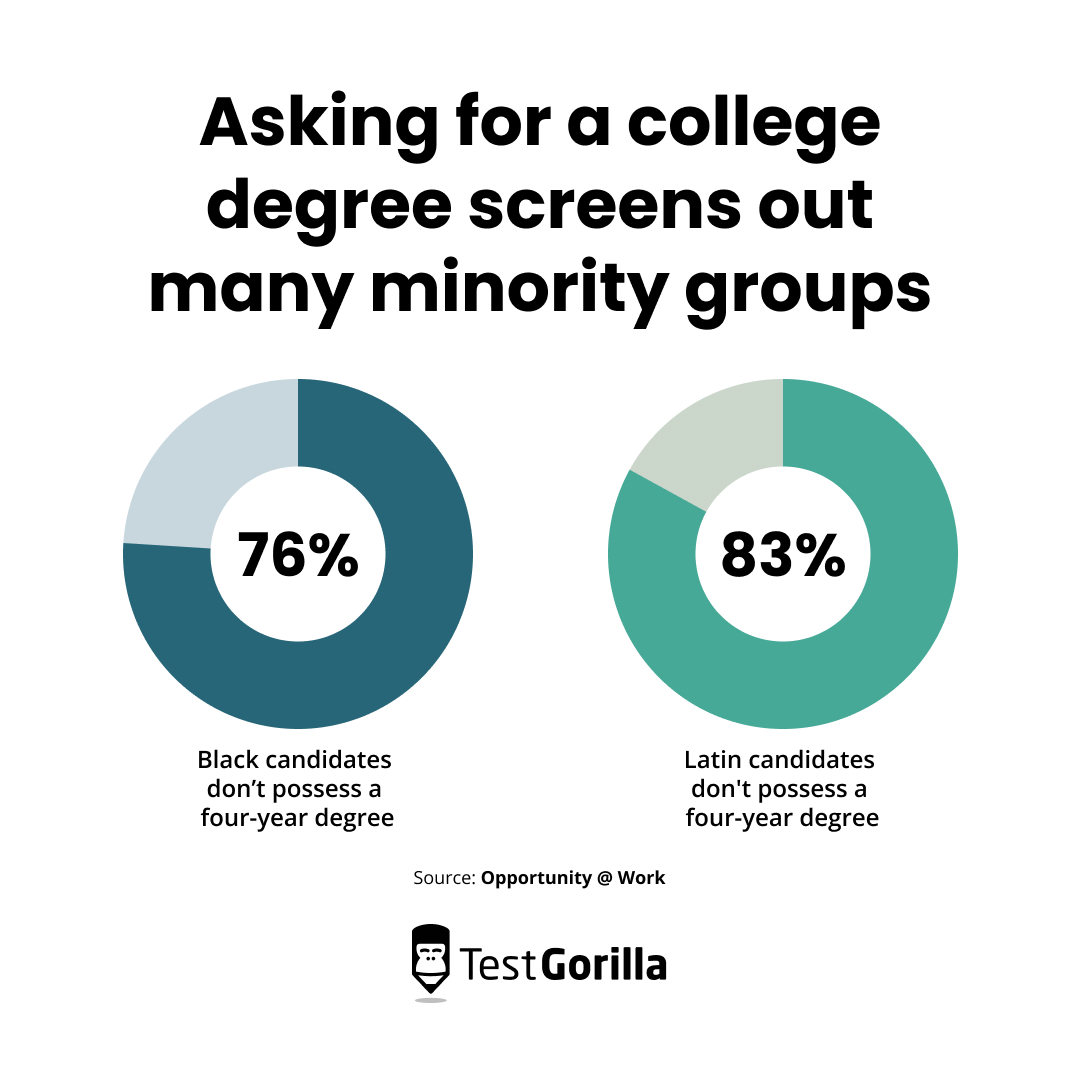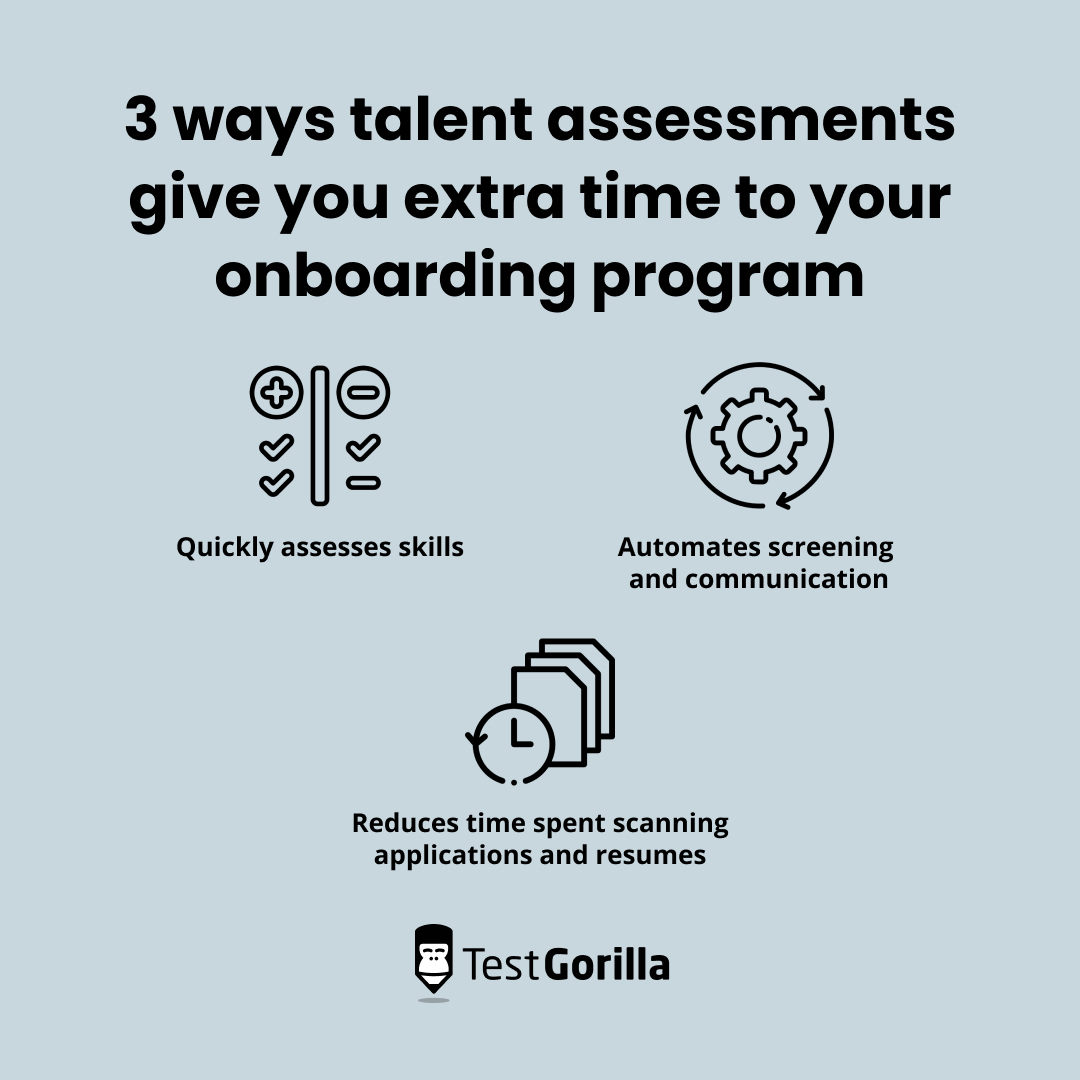Securing great talent is one of the highest priorities for HR professionals. Great candidates fuel your company, lead to better outcomes, and become your organization’s future leaders.
You need a reliable way to get great candidates – and it’s best if it’s also efficient and affordable.
Talent assessments are one of the top talent acquisition strategies in modern recruitment. They boost diversity, improve time-to-hire, and reduce total mis-hires.
A study by SHRM found that 78% of HR professionals say the quality of their organization’s hires has improved due to skills assessments.[1]
Let’s dive into the world of talent assessments, looking at the different types, the benefits of using them, and how to build them into a hiring strategy.
We also cover 28 use cases of talent assessments, providing in-depth guides for each. If you already know the basics of talent assessments, feel free to skip ahead to the use cases.
Table of contents
What is a talent assessment?
A talent assessment is a test used to determine a person’s skills, competencies, and aptitude. They’re most commonly used during hiring to evaluate candidates, but they can also be used to gauge employees’ learning and development needs.
These tests are useful for every type of company, but they’re particularly useful for tackling talent acquisition trends, like hiring remote employees and assessing behavioral competencies.
A talent assessment can take many forms. For example, it can be:
A structured interview
A set of skills or personality tests
A work sample
A job trial or a simulation
In most instances, candidates take tests online via dedicated talent assessment tools.
Companies can use these tools to share the results with prospective employees, but in practice, this part of the process usually remains hidden to optimize the hiring process and to minimize costs.
The benefits of talent assessment
Using talent assessment tests has a large impact on organizations, causing a ripple effect from candidate application and hiring to the employee experience.
Here are the top advantages, backed up by data from TestGorilla’s State of Skills-Based Hiring 2024 report:
Advantages | How companies benefited from skills-based hiring |
Improves quality of hire, avoiding costly mis-hires | Gained objective information on skills to make better decisions and avoid bad hires 90% saw a reduction in mis-hires |
Reduces bias | Made decisions based on skills, not unconscious bias 90% saw an increase in diversity |
Improves time-to-hire | Shortlisted candidates more efficiently and filled roles faster 81% saw a reduction in time-to-hire |
Increases retention | Hired people better suited to their roles, reducing turnover 91% saw an increase in retention |
Reduces cost-to-hire | Reduced internal and external recruiters’ billable time spent sifting through applications 78% saw a reduction in cost-to-hire |
But these numbers aren’t achieved through using one general “talent assessment.” There are different assessments for different positions and organizations.
The 7 types of talent assessment
There are a variety of methods to work into your talent assessment strategy.
To maximize your results, mix and match the different assessments according to the position you’re evaluating.
Here’s a quick summary of the different types of talent assessments:
Skill assessments
Cognitive ability tests
Personality and culture tests
Situational judgment tests
Language tests
Structured interviews
Job trials and simulations
1. Skill assessments
Skill assessments evaluate a candidate's hard skills and power skills.
Here’s a quick definition of each:
Power skills: Also called soft skills, these skills help us collaborate with others and get our work done efficiently, like time management and innovation.
Hard skills: These skills are technical, like financial math and marketing strategy. Most hard skills are role-specific.
2. Cognitive ability tests
Cognitive assessments test mental abilities – things that can’t show up on a resume.
Cognitive ability tests help assess skills like adaptability and learning speed. These skills were already crucial, but the rise of AI has made them even more essential.
3. Personality and culture tests
Traditional hiring methods aren’t able to assess important qualities like personality and culture.
Talent assessments enable you to gauge key personality traits and evaluate whether a candidate is a good culture add.
These tests also help you assess motivation.
4. Situational judgment tests
These tests empower you to assess how a candidate would react in a certain business situation.
Situational judgment includes business ethics, leadership and people management, and negotiation.
5. Language tests
Online talent assessments enable you to accurately gauge language proficiency. This helps you:
Include more international job candidates in your talent pool
Evaluate language proficiency faster and more efficiently than traditional methods like reading written assignments
6. Structured interviews
Structured interviews are interviews in which you ask all candidates the same questions in the same order. This lets you concentrate on each candidate’s skills and helps bring hiring bias to a minimum by eliminating small talk or unstructured questions.
7. Job trials and simulations
Job trials and simulations are great ways to evaluate candidates’ skills in realistic scenarios.
Here’s a quick definition of each:
Job trials: This is when you give a candidate a real-life work task to complete or hire them for a short probation period.
Job simulations: This puts a candidate in a realistic scenario via a program to assess their skills. This is a popular method for hiring programmers.
How to create a strong talent assessment framework
To properly leverage a talent assessment strategy, you need a solid talent assessment framework.
Here are our five top tips on how to build one.
1. Define clear objectives and criteria
Begin by defining what “top talent” means to your company.
Discuss with management what criteria candidates need to meet to excel at their position. You need to do this for every role because the specific job requirements vary.
Once you define the specific skills your ideal candidate must have, you have to determine how to measure these skills and which assessments to use.
2. Establish an effective hiring process
Your hiring process directly impacts the success of your hires and your company.
It’s imperative to use data-driven, well-structured methods to build your process. We recommend:
Building skills-based job descriptions
Using skills tests
Adopting structured interviews
Tossing out the need for resumes
These strategies should be all you need to get started. You can get ambitious later.
3. Set clear expectations about your talent assessment process
Words like “proficient” or “highly skilled” are subjective – one of the main issues with resumes.
This means you need to set clear expectations around your talent assessment process. Here are a few things to clarify:
Which skills need to be assessed and why
How you’ll use the results
Which skill levels you need for each skill
For more information on this, read our blog on how to set the bar in skills tests and assessments.
4. Review the results
Now you have to review the results of your assessments and shortlist candidates.
This step is simple when using online talent assessments like TestGorilla’s.
Quickly shortlist candidates by test score, and then examine the highest-scoring candidates individually.
Automatic filtering enables you to objectively view skills and competencies to find the ideal candidate. It isn’t time-consuming and unreliable, like scanning resumes.
Another standout from resumes: It’s unlikely a candidate can misrepresent their skills since most talent assessment tools have anti-cheating measures.
5. Continue testing to improve your talent assessment framework
As times change, so do your business’s needs. Assess high-performing employees regularly to verify you’re still testing candidates for the most important skills. Use this information to improve your testing framework – and your ability to hire the best talent.
28 proven use cases for talent assessments
Assessing talent doesn’t come in just one flavor.
Every industry, company, and role can benefit from different talent assessments, from hiring contractors to training current staff.
We’ve broken our top talent assessment examples into three categories:
How talent assessments help hire different types of candidates and job roles
How talent assessments help create an effective hiring process
How talent assessments help internal and employee processes
Talent assessment examples: A summary
Talent assessment use case | Summary and examples |
How talent assessments help hire different types of candidates and job roles | |
1. Assess from afar and hire remote employees | Accurately gauge capabilities without ever meeting a candidate in person |
2. Rehire former employees | Avoid possible bias and hire former employees for the skills they bring to the table |
3. Recruit Gen Z workers with the newest hiring methods | Give Gen Z workers the diversity-positive and technology-charged hiring process they want |
4. Design a millennial-approved process | Appeal to millennials’ desire for more upskilling opportunities |
5. Improve efficiency while recruiting passive candidates | Improve your branding and convince passive candidates to switch |
6. Give disabled candidates an equal chance | Remove unnecessary barriers and hire more disabled candidates |
7. Identify HiPo (high-potential) candidates | Discover high-potential candidates by assessing their true capabilities |
8. Accurately assess contractors and freelancers | Evaluate contractors without worrying about atypical resumes and references |
9. Identify the right interns | Find interns who are dedicated to your values and mission |
10. Find business managers that suit your company | Cut through generic job titles and find a manager who has the skills you need |
11. Identify executives who bring your culture to life | Hire executives who can confidently spread your message and values |
How talent assessments help create an effective hiring process | |
12. Build a better hiring process | Inform your hiring process from start to finish with talent assessments |
13. Facilitate high-volume hiring | Process applicants faster while maintaining quality |
14. Manage and organize your talent pool | Update your talent pool to make sure you’re hiring for the exact skills you need |
15. Reduce bias in hiring | Stop looking at name, gender, and race and hire candidates for skills |
16. Gauge your hiring needs accurately | Use talent assessments to determine what you need in a candidate |
17. Improve the candidate experience | Increase equality and ensure candidates have the skills to succeed to improve the overall experience |
18. Boost hiring efficiency | Assess skills and language proficiency quickly to increase speed and efficiency |
19. Improve hiring diversity and expand your workforce | Focus on skills and toss away unnecessary requirements to open your doors to diverse hires |
20. Spot quality candidates in a sea of talent | Determine quality quickly and accurately by using skills and personality tests |
21. Target and secure niche skills | Hire niche professionals confidently with skill-specific assessments |
How talent assessments help internal and employee processes | |
22. Assess training needs and monitor employee development | Execute, monitor, and verify employee training using talent assessments |
23. Build effective leadership development plans | Use talent assessments to see what qualities future leaders have and build a plan around it |
24. Make internal recruitment quick and easy | Access a database of pre-qualified internal candidates to fill open roles easily |
25. Create a solid onboarding plan | Give employees an idea of what your company is like before they start |
26. Facilitate employee promotions | Promote employees with the right skills and don’t just rely on experience and connections |
27. Identify and bridge key skills gaps | Use talent assessments to discover your workforce’s skills gaps and then hire talent to bridge them |
28. Reduce employee turnover and increase retention | Improve collaboration and satisfaction with talent assessments to reduce turnover |
1. Assess from afar and hire remote employees
Hiring remote employees is here to stay. This means companies need an effective way to assess remote skills.
Remote employees have unique hiring needs:
Remote work requires different skills, such as better time management and a stronger ability to understand instructions
Remote employees are tough to assess when your usual methods rely on being in the office
Many remote employees are outside your region and cannot come into the office
Building a talent assessment process is the perfect solution. It evaluates real skills, and it can do so from miles away.
For instance, Automattic, a fully remote software development company, has a skills-first hiring process using talent assessments.
It starts with an application and interview, but then the company presents paid trial projects to every applicant. It also sends coding tests to engineering candidates.
This process helps the organization gauge skills from all over the world: Automattic has workers in 95 countries.
2. Rehire former employees
Rehiring former employees is an important hiring strategy. This practice has many benefits, such as pre-qualified candidates and easier onboarding.
Talent assessments help by reducing bias toward or against former employees.
For example, if a manager spends a lot of time with this worker, they may turn a blind eye to missing skills.
On the other hand, if the manager witnessed this former employee get into a workplace conflict with their favorite worker, they might reject them despite their quality.
Focusing on skills also puts former employees into more suitable roles.
For instance, Kyle McCann was fired from his account manager role due to poor performance. His boss struggled with this decision due to Kyle’s motivation and dedication.
But he invited Kyle back to fill a role in customer service that matched his people skills and friendly personality.
Kyle’s boss knew his skill set well, but you can streamline this process by assessing talent with tests.
3. Recruit Gen Z workers with the newest hiring methods
Gen Z is the newest generation of workers, so old methods aren’t going to work. You need modern processes to match a modern workforce.
These professionals want a process that removes barriers to diversity. In fact, this generation is on track to be the most ethnically diverse yet: Nearly half of Gen Z are ethnic minorities.[2]
Coupa, an IT services company, had Gen Z in mind when it designed its recruitment process.
This company used talent assessments when hiring Gen Z candidates via a campus recruitment program.
The staff didn’t want to rely on resumes or university projects, which aren’t always representative of true skill and leave some stellar candidates out.
Coupa gauged its Gen Z candidates with coding and aptitude tests so the business could hire for skills, not whether or not the person aced a college project.[3]
4. Design a millennial-approved process
Designing the right hiring process for hiring millennials is imperative when they encompass 35% of the workforce.[4]
This generation needs an inclusive culture to feel connected to their workplace, and talent assessments help build a fair environment where people are recognized for skills.
They also prioritize learning and development. For this, you can use talent assessments for existing employees to upskill them and support their career growth.
Here’s how:
Use skills tests to find skills gaps
Assess employee progress along the way with the same tests
Finalize talent development and verify skills with talent assessments
This is exactly how Verizon engages its millennial workers – and 42% of its workforce is millennials and Gen Z.[5]
Using online talent assessments, this telecommunications company offers cybersecurity and IT learning experiences to its staff.
5. Improve efficiency while recruiting passive candidates
Recruiting passive candidates is crucial to your hiring strategy. These professionals are already qualified and aren’t being interviewed by other companies. But because they aren’t looking for a job, they can be difficult to recruit.
Talent assessments improve your employer branding. This is essential if you want to make an offer to a candidate and get them to switch to your company.
Let’s create a fictional example.
A skills-first company needs to hire for a high-priority cybersecurity role. To do this, it decides to market its use of talent assessments through its career page and social media channels.
It supports a strong message that skills-based hiring provides a fair experience and promotes diversity.
This company then mentions these great points to three passive candidates that it's been nurturing. And because 54.3% of candidates prefer a hiring process with skills tests, the business recruits and hires a talented passive candidate.
6. Give disabled candidates an equal chance
Hiring people with disabilities isn’t easy with traditional recruiting methods. Many disabled candidates lack traditional qualifications, such as college degrees and extensive work history.
And more than a quarter of the US population is disabled. This means traditional hiring methods are blocking 26% of adults from your talent pool.
Talent assessments can help.
Let’s say a company assesses its workforce and decides to include disability as a diversity metric. The results find it has only a small handful of disabled employees.
Its HR team decides to adopt talent assessments to close this gap and increase the amount of disabled candidates each hiring initiative gets.
Using talent assessments enables HR staff to hire without requiring certifications only certain people have. The team is also able to reduce reliance on confidence during interviews and give special accommodations, like extra time during skills tests.
7. Identify HiPo (high-potential) candidates
High potential employees (HiPos) have the skills to advance quickly to senior positions and might just be your company’s future leaders.
It’s nearly impossible to spot this potential in a resume.
But with talent assessments, you can spot great potential and nurture it. An employee talent assessment helps you foster skills and see them flourish.
A real-life example of this is 7Systems, a software development company that used TestGorilla talent assessments to predict job performance in candidates.
This company needed to hire for complex roles and struggled with traditional methods.
However, using talent assessments enabled it to spot high-potential employees. Candidates who scored high on tests were also highly successful in their roles after hiring.
8. Accurately assess contractors and freelancers
It can be difficult to gauge a contractor’s skills, which makes recruitment a headache.
Talent assessments solve the most common concerns when hiring a contractor:
They may have an atypical background
They have odd resumes with work gaps
Many contractors exclusively work remotely
Talent assessments make it simple to gauge their true abilities and evaluate them, no matter where they are in the world.
For example, let’s say a marketing agency needs to hire more freelance writers.
The hiring team reviews applications and then sends out a 1,000-word paid writing trial to determine if the writers can produce valuable content, follow the given brand and formatting guidelines, and copy-edit their work.
When the team receives the finished samples, they have hard evidence of the candidates’ writing talent.
9. Identify the right interns
Hiring interns is important to identifying future leaders and raising brand awareness to the next generation, but finding the right ones can be tricky.
Talent assessments help you discover interns who are truly dedicated to the role and make a strong addition to your culture.
Using tests like our Culture Add test and Motivation test in your talent assessment strategy reveals an intern’s ethics and values before day one.
McKinsey & Company, a famous global management consulting firm, knows the importance of using a talent assessment framework for interns.
This company uses its problem-solving tests to gauge new interns. These tests evaluate a candidate’s common sense and natural analytical skills and require no business background to complete.[6]
10. Find business managers that suit your company
Hiring a business manager isn’t straightforward.
The job title “business manager” is general, and many professionals may go by it. But they might also go by “director” or “coordinator.” This makes it hard to determine if someone is suitable for your role.
On top of that, business managers rely on key soft skills that resumes can’t detect.
Using talent assessments not only helps you find power skills like leadership and people management but also helps you differentiate one role from another.
This is why Ford, the automotive giant, uses talent assessments to evaluate its engineering managers.
The top two skills the people at Ford assess are verbal reasoning and numerical reasoning. These tests enable the automaker to find managers who hold key data comprehension and critical reasoning skills.[7]
They’re important skills to have, but they aren’t always clear on a resume.
11. Identify executives who bring your culture to life
Executive hiring is crucial to get right. The C-suite makes important decisions and cultivates your company culture. Plus, the executive cost-per-hire is $28,000 on average, making mis-hires detrimental.
Creating a talent assessment strategy prevents costly mis-hires. Our report found that 90% of organizations using skills-based hiring reduced mis-hires.
Assessing talent also helps align your future executives to your values and mission.
For example, let’s say an organization is hiring an executive. The team knows it’s important that an executive aligns with company culture and has a leadership style that properly motivates and engages employees.
The hiring team uses culture and personality assessments to find a leader who shares the company’s motivation. This not only keeps their company culture strong but also causes a ripple effect throughout the company, reducing overall conflict.
12. Build a better hiring process
It pays to spend time improving your entire hiring process.
A vague job ad leads to receiving applicants that match only some of your requirements. And if you conduct interviews that rely on charisma, unqualified applicants may get through the door.
A talent assessment strategy informs your hiring process from start to finish. For example, using talent assessments to discover your workforce’s skills gaps leads to building an accurate job description, helping you get relevant applicants.
Digital Care, a business process outsourcing company, used TestGorilla’s talent assessments to improve its hiring process.
This company conducted numerous phone interviews with candidates who didn’t have the skills for the role, wasting the recruiter’s and each candidate’s time.
After it switched to talent assessments, the hiring process got faster and more efficient. Best of all, it produced high-quality candidates.
13. Facilitate high-volume hiring
High volume hiring is when a company recruits large numbers of candidates in a short amount of time. Although it’s necessary, this process can increase the number of unqualified candidates you receive due to time and energy constraints.
Talent assessments help boost candidate quality through objective testing, and they increase efficiency thanks to recruiting automation.
A talent assessment process also improves the candidate experience in an atmosphere where it’s difficult to give attention to individual candidates.
Walmart, a famous retail company, uses talent assessments to assess values, culture, and aptitude in its hiring process.[8]
These assessments help this company keep up with its massive hiring volume. In fact, Walmart is the Fortune 500 company with the largest number of employees in the world: 2.3 million people.
14. Manage and organize your talent pool
Having a full talent pool speeds up hiring and improves candidate quality. But that’s only if you keep up with talent pool management.
Updating your talent pool is simple when you use talent assessments to determine necessary skills, boost diversity, and bring in internal candidates for consideration.
Needs change over time, so it's important to regularly assess your workforce and discover skills gaps and important diversity metrics.
For example, let’s say an HR professional uses talent assessments to evaluate their workforce every quarter to check for shifting needs and priorities. They then update their talent pool accordingly.
This ensures it isn’t stale or outdated. Candidates that seemed like likely hires three months ago might not fit the bill anymore.
15. Reduce bias in hiring
Bias is a natural part of human instinct that we all possess, but it’s detrimental to candidate quality when hiring.
It’s imperative to reduce bias in hiring so we can recruit the best candidate available.
Talent assessments focus on skills over everything else, leveling the playing field and giving everyone a fair chance. This dramatically reduces bias, increasing diversity and improving quality of hire.
Jigsaw Business Solutions, a gift card program company, experienced this firsthand when they adopted a talent assessment strategy.
Before, this company struggled with making confident hiring decisions because it knew it had no real way to discover a candidate’s abilities.
Using talent assessments enabled this company to make its hiring process fairer and more objective. This helped their hiring team reduce bias and focus on skills, leading to better hires.
16. Gauge your hiring needs accurately
Knowing your hiring needs directly impacts the success of your recruitment. It’s simple to post a job ad, but unless you determine what your needs are, your applicants may not be suitable.
Talent assessments help you identify your hiring needs, such as current and future talent gaps.
For example, let’s say a human resources manager at a tech company needs to hire a new IT technician.
First, they conduct a talent assessment for existing employees to discover which key tech skills their workforce is missing.
After analyzing the results, they determine that the simplest solution is to upskill one current employee, and then use the data to write a skills-based job description for the next hiring initiative.
17. Improve the candidate experience
Candidates want a positive hiring experience, and it could damage your employer brand if they don’t get it.
Talent assessments improve candidate experience in a number of ways, such as reducing bias and gauging candidates on skills, not experience.
They also ensure new employees have the skills they need to succeed.
This was the case for TruTrip, a business travel management company. It lacked a solid method for measuring its candidates’ skills, which led to a poor candidate experience and an unfavorable employee experience.
This company had no way to test if employees had the skills to work remotely or if their English proficiency was at the right level.
Using talent assessments enabled TruTrip to increase engagement and improve each candidate’s initial experience, leading to a better employer brand.
18. Boost hiring efficiency
The longer a role sits open, the longer a company misses out on important work. This means hiring efficiency is a top priority.
Talent assessments boost efficiency in so many ways, cutting out some of the most tedious parts of hiring:
Screening resumes
Contacting references
Determining language proficiency
A real-life example of this is Revolut, a financial services company2 that improved its efficiency with talent assessments.
Being a European company means evaluating language proficiency is a normal part of the hiring process, but its team spent too much time on language assessments.
This team traded out their written assignments for TestGorilla’s language tests and reduced their time-to-hire by 40%. This also boosted overall proficiency and reduced human error.
19. Improve hiring diversity and expand your workforce
There are few ways around it – traditional hiring stifles diversity.
Diversity hiring struggles in a traditional hiring process due to:
Requiring college degrees screening out many minority groups (for example, 76% of Black candidates don’t possess a four-year degree)
Unconscious bias through resumes and interviews
DE&I targets, although well-intentioned, suffering from tokenism and neglecting certain forms of diversity
Talent assessments improve diversity by focusing on skills and personality – not a person’s background.
For example, an anonymous e-commerce company used talent assessments to increase the number of women in its tech department in an attempt to solve STEM inequality.
This company realized the importance of using unbiased assessments to boost diversity. Because of that, it attracted around 6,500 female students from various tier-1 tech institutions across India.[9]
20. Spot quality candidates in a sea of talent
We wish it was as easy as putting a job ad out for “quality candidates” and calling it a day.
Picking out which candidates are promising, talented, and potential future leaders is difficult with traditional hiring, if not impossible.
Assessing talent helps you confidently identify quality candidates. They not only objectively assess technical skills, like Scala coding, but also gauge important power skills that quality candidates possess, such as collaboration and adaptability.
Google is well-known in the hiring world for this one.
This major search engine proudly and openly talks about assessing talent through structured interviews. These interviews toss away irrelevant, unplanned questions like “How many gas stations are there in Manhattan?” which are only there to throw candidates off.
How successful are they in spotting quality candidates? Unstructured interviews predict 14% of job performance, while structured interviews predict an impressive 26%.[10]
21. Target and secure niche skills
Niche skills are particular and specific. This makes them difficult to spot and evaluate.
If your next niche hire doesn’t work out, the cost could be tremendous – and it will take some time to fill the role again.
Talent assessments enable you to pick out specialty skills like a needle in a haystack.
Skills tests don’t lie, so gauging niche skills with them creates a solid process you can be confident in.
Estrin Legal Staffing struggled with this before building a talent assessment framework.
This company ran into difficulties properly assessing specific legal skills, but because of TestGorilla’s library of more than 300 talent assessments, its team can evaluate roles they never could before.
22. Assess training needs and monitor employee development
Employee training and development is expected in today’s working world, but it’s tricky to know who’s ready for growth, who’s done with their training, and who’s suited to which role.
Talent assessments answer all three of these and more.
Employee talent assessment gives you visibility into each worker’s development and growth, providing clear data on which employee needs more training and which one is ready for new responsibilities.
Vikram Tea, a tea manufacturer and supplier, used a talent assessment platform to evaluate its staff to discover training needs and upskilling opportunities.
Using skills tests for development enabled this company to create a customized framework for each employee, personalizing their growth and improving outcomes.[11]
23. Build effective leadership development plans
Creating leadership development plans is essential for positive future growth, but not every leader has the same needs.
Maybe your company prioritizes results over long hours, and you need leaders that reflect that. Or perhaps a future leader has one skill that’s lagging behind and needs a targeted development program.
Subway, a popular fast-food chain, uses talent assessments for leadership development.
One particular Subway store adopted skills tests as a way to better understand its employees’ strengths and weaknesses. But as a consequence, its team discovered key personality traits and motivators to help them place leaders for existing and future stores.[12]
24. Make internal recruitment quick and easy
Internal recruitment is cost-effective, and the more you promote from within, the higher satisfaction and retention climb.
However, there are roadblocks that get in the way, such as bias and a lack of diversity. It’s also difficult to know whether or not you have talent available to fill a role.
Talent assessments make internal mobility easy by measuring skills and enabling you to keep them on file. You can then quickly refer to your database when a role opens up.
Telkom, an information and communications technology company, used talent assessments to answer a huge question about its future: recruit or develop?
With the help of skills tests, this company chose both. After a company-wide skills gap analysis, its team discovered which skills the company needed and worked to bridge the gap with both internal and external recruits.[13]
25. Create a solid onboarding plan
New employee onboarding is essential; it’s an employee’s first impression of your company.
Online talent assessments help candidates get an idea of your culture and values. It’s also easier for them to hit the ground running because their skills are a match for the role, helping them ramp up faster.
Talent assessments help in another way: They save you time and effort that you can pour into your onboarding program.
Accelerated Solutions, an IT and business consulting company, used skills tests for this exact purpose.
After switching to talent assessments, its recruiters wasted less time on unqualified candidates and hired the right candidates faster. This enabled them to put their everything into a solid onboarding experience for their new hires.
According to Haitham Babeyeh, Axelerated’s Operations Manager, the company’s probation period passing rate is now much higher thanks to this excellent onboarding.
26. Facilitate employee promotions
Traditional methods of deciding which employees to promote aren’t reliable indicators of skills.
To determine which workers get promotions, many companies look at how long an employee has worked for them or consider their years of experience.
The best way to give employee promotions is by determining their skills through talent assessments. This promotes a fair experience and ensures your company gets reliable talent in important roles.
For example, let’s say a manager in a sales team sees great potential in a sales representative who’s only been with them for a year.
They evaluate this worker with talent assessments, and after reviewing the results, they promote them to account executive.
This quick career growth boosts retention in the current employee, and it also tells potential hires a lot about the organization’s development programs.
27. Identify and bridge key skills gaps
Skills gaps are getting wider as technology marches on, and businesses need new capabilities every day to function properly.
Technology like AI is making some jobs obsolete while rapidly creating new ones.
You can keep up with this constantly shifting landscape by using talent assessments to conduct a skills gap analysis and discover which skills your organization needs to stay ahead of the curve.
This gives you actionable information on which candidates to target or which employees to upskill.
One of the biggest skills gaps is in the tech sector, and it’s why IBM uses a variety of talent assessments to bridge the gap and find great hires.
This company is committed to securing new tech talent from atypical areas, such as former nurses and baristas. This talent is hidden from traditional hiring practices because of “irrelevant” work experience.[14]
IBM’s talent assessments get around this. It evaluates candidates with job simulations to test their skills, not judge their experience.[15]
28. Reduce employee turnover and increase retention
It’s crucial to reduce employee turnover and increase retention. These important metrics indicate a healthy workplace and show how quickly employees come and go.
Talent assessments increase retention for a number of reasons, including matching candidates to a job they’re confident in and aligning them with a culture they identify with.
In fact, our report found that 91% of organizations that use skills-based hiring saw an increase in retention.
O’Reilly Hospitality Management, a hospitality firm, improved its turnover with the help of talent assessments.
This company assessed the behavioral competencies of its current staff to foster collaboration and improve team dynamics. Talent assessment for existing employees helps show you different working styles so you can promote better teamwork.
These efforts reduced overall company turnover by 20% and reduced turnover at certain properties by 50% to 70%.
This initiative worked so well that HR decided to expand its use of talent assessments to the next hiring efforts.[16]
Hire the best candidates with talent assessments
Talent assessments come in many varieties and can be used for hiring, training, and even improving metrics like retention.
Your talent assessment strategy can leverage several of these use cases to improve your processes.
But why not start small and just try two or three, like reducing bias and hiring remote employees?
To continue learning about talent assessments, read our blog on skills assessment tools.
To browse our database of more than 300 talent assessments, check out our test library.
Talent assessment FAQs
Here are a few answers to some common talent assessment questions.
How do you identify the right talent?
Evaluate your role with a skills gap analysis to gain insights into the skills required. Then assess the candidate objectively by using talent assessments to discover their skills, personality, and competencies.
Why is talent assessment important?
Assessing talent increases your accuracy in identifying quality candidates and reduces the chance of mis-hires.
This has the added bonus of making your hires more confident in their work and increasing retention.
What are the different types of talent assessment?
The main types of talent assessments are skills tests, cognitive ability tests, personality tests, situational judgment tests, language tests, structured interviews, and job simulations.
Using a variety of these enables you to build a holistic hiring process to look at the whole candidate, giving you better insights.
How do you conduct a talent assessment?
Assess your company’s needs, choose the talent assessments most suited to the role, and send them to the appropriate candidates.
You then review the results and make a decision based on skills and competencies, instead of screening resumes.
Sources
1. Maurer, Roy. (August 31, 2022). "Using Skills Assessments Over Education, Experience Requirements". SHRM. Retrieved August 28, 2023. https://www.shrm.org/resourcesandtools/hr-topics/talent-acquisition/pages/using-skills-assessments-over-education-experience-requirements.aspx
2. Fry, Richard; Parker, Kim. (November 15, 2018). "Early Benchmarks Show ‘Post-Millennials’ on Track to Be Most Diverse, Best-Educated Generation Yet". Pew Research. Retrieved August 28, 2023. https://www.pewresearch.org/social-trends/2018/11/15/early-benchmarks-show-post-millennials-on-track-to-be-most-diverse-best-educated-generation-yet/
3. "Coupa hires fresh graduates using iMocha". iMocha. Retrieved August 28, 2023. https://www.imocha.io/case-studies/coupa-case-study-seamlessly-conducted-university-hiring-drive
4. Fry, Richard. (April 11, 2018). "Millennials are the largest generation in the U.S. labor force". Pew Research. Retrieved August 28, 2023. https://www.pewresearch.org/short-reads/2018/04/11/millennials-largest-generation-us-labor-force/
5. "Verizon Communications Demographics and Statistics". Zippia. Retrieved August 28, 2023. https://www.zippia.com/verizon-careers-12380/demographics/
6. Ritter, Sebastien. "All About The McKinsey Recruitment Process". Career in Consulting. Retrieved August 28, 2023. https://careerinconsulting.com/mckinsey-recruitment-process/
7. "How to Pass the Ford Pre-Employment Assessment Test?". (October 5, 2022). Assessment Centre HQ. Retrieved August 28, 2023. https://www.assessmentcentrehq.com/ford-test/
8. "A Complete Overview on Walmart Assessment Tests". M Consulting Prep. Retrieved August 28, 2023. https://mconsultingprep.com/walmart-assessment-tests
9. "Enabling diversity hiring". Mercer Mettl. Retrieved August 28, 2023. https://mettl.com/clients/leading-ecommerce-player/
10. Bock, Laszlo. (April 7, 2015). "Here's Google's Secret to Hiring the Best People". Wired. Retrieved August 28, 2023. https://www.wired.com/2015/04/hire-like-google/
11. Boosting sales recruitment and L&D for Vikram Tea". Mercer Mettl. Retrieved August 28, 2023. https://mettl.com/clients/vikram-tea/
12. "A fresh take: How Subway improved employee and customer experience with PI". The Predictive Index. Retrieved August 28, 2023. https://www.predictiveindex.com/customer-stories/subway-case-study/
13. "Building a future-ready workforce: How Telkom led its employees on the path of digital transformation". Mercer Mettl. Retrieved August 28, 2023. https://mettl.com/clients/telkom/
14. "All Hands: IBM’s Obed Louissaint on the Importance of Skills-Based Hiring". (July 7, 2022). Lattice. Retrieved August 28, 2023. https://lattice.com/library/all-hands-ibms-obed-louissaint-on-the-importance-of-skills-based-hiring
15. Arnold, Jennifer. (February 20, 2018). "How to Adopt Skills-based Hiring Practices". SHRM. Retrieved August 28, 2023. https://www.shrm.org/hr-today/news/hr-magazine/0318/pages/hiring-for-skills-not-pedigree.aspx
16. "How PI helped a hospitality group reduce turnover and increase headcount". The Predictive Index. Retrieved August 28, 2023. https://www.predictiveindex.com/customer-stories/oreilly-hospitality-management-case-study/
Related posts
Hire the best candidates with TestGorilla
Create pre-employment assessments in minutes to screen candidates, save time, and hire the best talent.
Latest posts
The best advice in pre-employment testing, in your inbox.
No spam. Unsubscribe at any time.

Hire the best. No bias. No stress.
Our screening tests identify the best candidates and make your hiring decisions faster, easier, and bias-free.
Free resources
This checklist covers key features you should look for when choosing a skills testing platform
This resource will help you develop an onboarding checklist for new hires.
How to assess your candidates' attention to detail.
Learn how to get human resources certified through HRCI or SHRM.
Learn how you can improve the level of talent at your company.
Learn how CapitalT reduced hiring bias with online skills assessments.
Learn how to make the resume process more efficient and more effective.
Improve your hiring strategy with these 7 critical recruitment metrics.
Learn how Sukhi decreased time spent reviewing resumes by 83%!
Hire more efficiently with these hacks that 99% of recruiters aren't using.
Make a business case for diversity and inclusion initiatives with this data.

